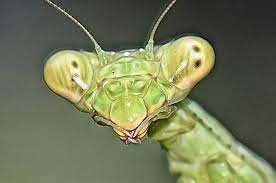
By any name, these fascinating insects are formidable predators. They have triangular heads poised on a long “neck,” or elongated thorax. Mantids can turn their heads 180 degrees to scan their surroundings with two large compound eyes and three other simple eyes located between them.
The closest relatives of mantises are termites and cockroaches (Blattodea), which are all within the superorder Dictyoptera. Mantises are sometimes confused with stick insects (Phasmatodea), other elongated insects such as grasshoppers (Orthoptera), or other unrelated insects with raptorial forelegs such as mantisflies (Mantispidae). Mantises are mostly ambush predators, but a few ground-dwelling species are found actively pursuing their prey. They normally live for about a year. In cooler climates, the adults lay eggs in autumn, then die. The eggs are protected by their hard capsules and hatch in the spring. Females sometimes practice sexual cannibalism, eating their mates after copulation.
Most mantises stalk tempting prey if it strays close enough, and will go further when they are especially hungry. Once within reach, mantises strike rapidly to grasp the prey with their spiked raptorial forelegs.[40] Some ground and bark species pursue their prey in a more active way. For example, members of a few genera such as the ground mantises, Entella, Ligaria, and Ligariella run over dry ground seeking prey, much as tiger beetles do.
Picture Credit : Google




